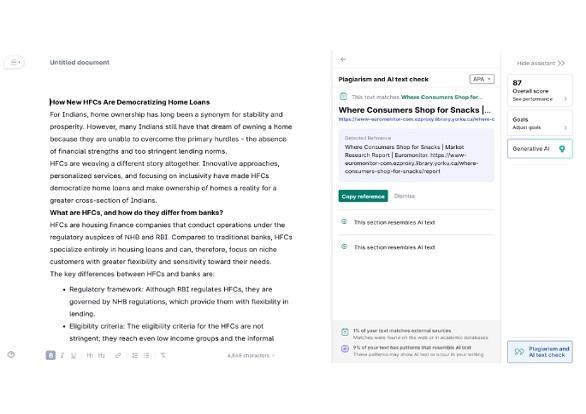How New HFCs Are Democratizing Home Loans
By Impact Desk | Updated: November 28, 2024 16:16 IST2024-11-28T16:11:44+5:302024-11-28T16:16:38+5:30
For Indians, home ownership has long been a synonym for stability and prosperity. However, many Indians still have that ...

How New HFCs Are Democratizing Home Loans
For Indians, home ownership has long been a synonym for stability and prosperity. However, many Indians still have that dream of owning a home because they are unable to overcome the primary hurdles - the absence of financial strengths and too stringent lending norms. HFCs are weaving a different story altogether. Innovative approaches, personalized services, and focusing on inclusivity have made HFCs democratize home loans and make ownership of homes a reality for a greater cross-section of Indians.
What are HFCs, and how do they differ from banks?
HFCs are housing finance companies that conduct operations under the regulatory auspices of NHB and RBI. Compared to traditional banks, HFCs specialize entirely in housing loans and can, therefore, focus on niche customers with greater flexibility and sensitivity toward their needs.
The key differences between HFCs and banks are:
Regulatory framework: Although RBI regulates HFCs, they are governed by NHB regulations, which provide them with flexibility in lending.
Eligibility criteria: The eligibility criteria for the HFCs are not stringent; they reach even low income groups and the informal sector workers.
Innovative products: HFCs design loan products that are customized, including those targeting affordable housing, which banks usually tend to ignore.
The rise of new HFCs in India
The HFCs have, in recent times, witnessed huge in-flows of new players that have a focus on innovation, on principles of inclusion, and customer-centric approaches. Such new entrants have vastly turned the market dynamics by filling gaps in which traditional banks had once left.
Focus on affordable housing - A primary target that has been inordinately important in the attainment of India's urban development goals has been affordable housing. New HFCs, including Bajaj Housing Finance, have focused their offering through the achievable EMIs for borrowings by low- and middle-income families. Reach penetration in semi-urban and rural geographies - New HFCs are also penetrating all market segments: Tier 2 and Tier 3 cities, and rural markets. They are taking home loans to such previously excluded demographics by catering to local needs and using digital technologies to reach them. Streamlining loan approval process - Traditional banks are largely bogged by cumbersome, time-consuming loan approval procedures. HFCs avoid this major pain area by embracing simple digital processes that enable faster approval and disbursal.
Key innovations driving the democratization of home loans
Flexible eligibility norms
In this context, HFCs are different from banks, as the latter are more credit score-dependent and formally dependent on income documents. For instance, self-employed and gig workers who do not have proof of steady income are provided access to housing loans.
HFCs normally look at cash flow statements, utility bills, or other proof of income.
Lower interest rates and attractive schemes
The best interest rates are one of the prime characteristics of new HFCs. Most institutions introduce promotional offers for first-time homebuyers. In this regard, Bajaj Housing Finance has rolled out provisions under the Max Funding strategy, through which loans can be offered with favorable terms to eligible customers.
Tech-driven solutions
The addition of technology has experienced a paradigm shift in the way HFCs interact with their clients:
Online portals: Self-serve eligibility, product comparison, and loan application.
AI-powered credit assessments: Faster and more thorough credit evaluations shorten the timeline to approval of non-traditional borrowers.
Mobile apps: Loan management via mobile applications are very accessible. EMI tracking and customer support at the tip of the users' fingers.
Exploring the socioeconomic impact of HFCs
Empowering the underserved
It only targets the inclusion policies of new HFCs. With regard to that, in order to provide products only available for the economically weaker sections (EWS) and lower-income groups (LIG), companies have opened channels which would otherwise be out-of-reach for most people during buy-to-becoming a homeowner.
Growth in real estate
Advantageous thing has been that the real estate sector, especially in the affordable housing category, is booming with the availability of cheap home loans. Given the awareness that there were funds available for prospective buyers to invest in them, the developers are encouraged to create housing projects in Tier 2 and Tier 3 cities.
Economic growth is triggered
Increased demand for homeownership has been a positive ripple effect of home loans on ancillary industries, such as construction, interior designers, and home appliances. The ripple effect from home loans does not stop at the financial sector but brings about an economic growth regime.
Challenges and how HFCs are addressing them
Regulatory constraints
While HFCs are permitted to operate with ease, they do not escape the clutches of NHB and RBI regulations that sometimes compel them to forgo their innovative ideas. However, most HFCs remain connected with the policy-making agencies to plead for reforms, which includes higher guarantee covers for affordable housing loans.
Bank competition
Banks can't be outsmarted because they boast of having a large network and good reputation. The HFCs are counter this by doing their best in personal services and niche markets.
Financial literacy among borrowers
Less educated about loan options and terms, many a time this means homebuyers steer clear of it. On this count, HFCs are investing in the education of customers, workshops, webinars, and digital content.
Why have HFCs become the preferred choice?
For potential homebuyers in India, the choice between HFCs and banks largely depends on factors like the loan amount, eligibility, and repayment terms. New HFCs are emerging as the preferred choice due to the following reasons:
Customer-centric approach: Personalized services catering to diversified customer needs.
Innovative products: Tailored solutions based on specific demographics, such as women or senior citizens.
Accessibility: Wider reach in semi-urban and rural areas, allowing more Indians to own houses.
Conclusion
New entrants in the Housing Finance Companies space have brought in a new dimension to the home loan market. Being innovation-centric, inclusive, and customer-friendly, HFCs are breaking barriers across avenues to homeownership. Be it flexibility in eligibility criteria or interest rates or to be driven through technology-enabled processes, HFCs are democratizing home loans and turning aspirations of crores into reality. So, if you are planning to buy a home in India, check out the offerings provided by HFCs and see if it aligns with your financial interests.
Open in app
